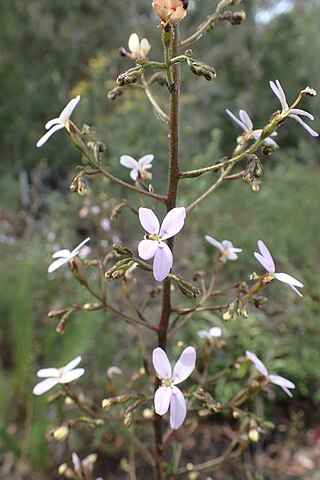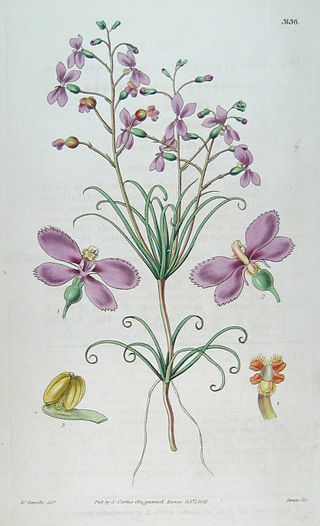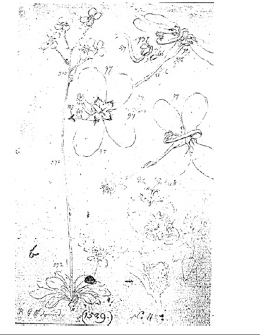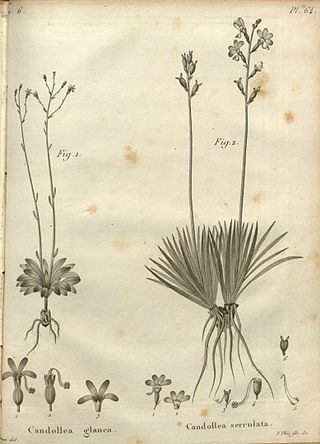Juliet Ann Wege (born 1971 in Western Australia) is an Australian botanist. She graduated in 1992 and gained a PhD at The University of Western Australia in 1999 with a thesis titled "Morphological and anatomical variation within Stylidium (Stylidiaceae): a systematic perspective". [1] As of 2021 she works as a researcher at the Western Australian Herbarium run by Western Australia's Department of Biodiversity, Conservation and Attractions and is managing editor of Nuytsia. [2] Her main area of expertise is in taxonomy and study of the Stylidiaceae family of triggerplants. [3] [4]
During 2005 and 2006 she was the Australian Botanical Liaison Officer at the Royal Botanic Gardens in London, England.

Stylidium is a genus of dicotyledonous plants that belong to the family Stylidiaceae. The genus name Stylidium is derived from the Greek στύλος or stylos, which refers to the distinctive reproductive structure that its flowers possess. Pollination is achieved through the use of the sensitive "trigger", which comprises the male and female reproductive organs fused into a floral column that snaps forward quickly in response to touch, harmlessly covering the insect in pollen. Most of the approximately 300 species are only found in Australia, making it the fifth largest genus in that country. Triggerplants are considered to be protocarnivorous or carnivorous because the glandular trichomes that cover the scape and flower can trap, kill, and digest small insects with protease enzymes produced by the plant. Recent research has raised questions as to the status of protocarnivory within Stylidium.

Stylidium laricifolium, commonly known as giant trigger-plant, larch-leaf or tree triggerplant, or is a species of flowering plant in the family Stylidiaceae and is endemic to eastern Australia. It is a perennial subshrub with many linear leaves crowded along its few stems, the flowers white to pale pink and arranged in a single main panicle and smaller racemes.
Nuytsia is a peer-reviewed scientific journal published by the Western Australian Herbarium. It publishes papers on systematic botany, giving preference to papers related to the flora of Western Australia. Nearly twenty percent of Western Australia's plant taxa have been published in Nuytsia. The journal was established in 1970 and has appeared irregularly since. Kevin Thiele and Juliet Wege have been in the editorial committee.

Tolypangium is a subgenus of the genus Stylidium that is characterized by ovoid to longish capsules. This subgenus was part of the earliest taxonomic division among the triggerplants. Stephan Ladislaus Endlicher first split the genus into two subgenera in 1838: Tolypangium with its ovoid capsules and Nitrangium with its linear capsules. Subsequent authors generally followed this classification, which is based almost entirely on the features of the capsule. Recent genetic analysis, combined with an exhaustive morphological comparison, has revealed that the classification defined by Johannes Mildbraed in 1908 is not the most accurate description of how the members of different subgenera and sections are related. As part of the Flora of Australia series, Juliet Wege will be reviewing and updating the taxonomy of the Stylidiaceae.

Verticillatae is a section in the subgenus Tolypangium that is characterized by globose capsules. Recent genetic analysis, combined with an exhaustive morphological comparison, has revealed that the classification defined by Johannes Mildbraed in 1908 is not the most accurate description of how the members of different subgenera and sections are related. As part of the Flora of Australia series, Juliet Wege will be reviewing and updating the taxonomy of the Stylidiaceae.
Repentes is a section in the subgenus Tolypangium. Repentes is a group of creeping triggerplants known as the locket triggerplants, related to subgenus Nitrangium section Appressae. They possess adpressed stem leaves bearing a small basal spur and uni-flowered inflorescences. Because section Repentes morphologically resembles the other creeping triggerplants in section Appressae, Allen Lowrie et al. (1999) proposed all species in this section be moved to section Appressae and Repentes be placed into synonymy. Juliet Wege (2006), however, argued that these species are morphologically distinct from those in section Appressae, citing trichome and column cunabulum structure as distinctions that separate the sections.
Stylidium aceratum is a dicotyledonous plant that belongs to the genus Stylidium. It occurs within the south west region of Western Australia
Stylidium diceratum is a dicotyledonous plant that belongs to the genus Stylidium. The specific epithet diceratum is Greek for "two horns", referring to the two appendages that are present on the bend of the gynostemium. It is an annual plant that grows from 15 to 35 cm tall. The longer leaves are lanceolate and the shorter ones are spathulate, forming a basal rosettes around the stem. The leaves are around 5–8 mm long and 0.2-2.5 mm wide. Inflorescences are around 6–15 cm long and produce flowers that are orange with dark orange and pink veins and bloom from June to August in their native range. S. diceratum is only known from the type location, which is at creek crossings on the road to Beverley Springs in the Kimberley region of Western Australia. Its habitat is recorded as being sandy soils on creek margins. It grows in the presence of S. ceratophorum, S. rubriscapum, Drosera caduca, D. paradoxa, Byblis liniflora, and Grevillea pteridifolia. S. diceratum is most closely related to S. longicornu, but it can be confused with S. ceratophorum, which also has an orange corolla but twice as large.
Stylidium weeliwolli is a dicotyledonous plant that belongs to the genus Stylidium. It occurs in the North West of Western Australia
Stylidium inaequipetalum, the Ayers Rock triggerplant, is a small herbaceous perennial plant in the genus Stylidium. It grows from 7 to 40 cm tall. Oblanceolate leaves, about 20-100 per plant, form a basal rosette with stems absent. The leaves are generally 15–81 mm long and 2–8 mm wide. This species produces 1-11 scapes per plant. Inflorescences are 7–40 cm long and produce pink flowers with petals all free and blooms almost year-round in their native range. S. inaequipetalum is endemic to the southwestern Northern Territory and Western Australia. Its typical habitat has been reported as sandy soils on sheltered creekbanks or in between rocks. S. inaequipetalum is most closely related to S. floribundum, though it is also closely allied with S. debile.
Stylidium imbricatum, the tile-leaved triggerplant, is a dicotyledonous plant that belongs to the genus Stylidium. It is an herbaceous perennial that grows from 12 to 50 cm tall and has divided stems covered with tile-like leaves that are arranged in a spiral formation around the stem. The ovate-elliptic leaves are basifixed and held closely against the stems. The leaves are around 1.5-1.8 mm long and 0.6-0.8 mm wide. Terminal inflorescences are racemose or spike-like and produce flowers that are reddish violet with laterally-paired lobes and bloom from April to May in their native range. S. imbricatum is only known from south-western Western Australia in Stirling Range National Park and Porongurup National Park south-east to Cheynes Beach. Its habitat is recorded as being sandy or laterite soils in swampy areas, rocky slopes, or heathland. S. imbricatum is distinct within its subgenus because it possesses obovate sepals. Its conservation status has been assessed as secure.

Stylidium perplexum is a species of triggerplant that is endemic to south-west Western Australia. It is a tuberous species that has many stems and has been described as "somewhat shrubby" at 15–40 cm tall. The linear leaves can be 2 cm long and are arranged around the stem in a rosette at the stem apices. The 8–19 cm tall scapes bear 6 to 14 flowers that are white with purple accents and corolla lobes that are laterally paired and 4–6 mm long.

Stylidium rupestre is a dicotyledonous plant that belongs to the genus Stylidium, a species sometimes named as the rock triggerplant. It is found in Southwest Australia. The species was first described by Otto Wilhelm Sonder.

Stylidium spathulatum is a dicotyledonous plant that belongs to the genus Stylidium. The species is informally named the creamy triggerplant for the colour of its flowers.

Stylidium affine is a species in the genus Stylidium that is endemic to Western Australia.
Stylidium asymmetricum, the asymmetric triggerplant, is a flowering plant species of the genus Stylidium and is endemic to south-west Western Australia. It is an annual plant from 2 to 16 cm high that grows at the margins of swamps in clay soils. It is only known from two populations in the Northern Jarrah Forest south-west of York and thus it was listed as Priority Two under the Declared Rare and Priority Flora List and more work is necessary to determine the population stability and existing threats, such as feral pigs and off-road vehicles, to the plants. The species epithet asymmetricum refers to the marked asymmetrical corolla arrangement, where the uppermost posterior lobe and the uppermost anterior lobe of the corolla meet at nearly a 90 degree angle, giving the flower a lopsided appearance.

Stylidium nymphaeum is a climbing triggerplant found along the southern coast of Southwest Australia. The species uses the curved tips of its leaves to clamber over nearby plants, attaining a height between 1.4 and 2.5 metres. These leaves are long and slender, between 15 and 75 millimetres in length and 0.8 to 2 millimetres in width, are hairless, and have an entire margin. The scape is also hairless. The flowers are pink to purple, appearing from December or January to May.

Stylidium glaucum, the grey triggerplant, is a herbaceous plant found along the southern coast of Southwest Australia, West of Albany. The plant attains a height between 0.15 and 0.65 metres. The leaves are lanceolate in form, becoming pointed at the base, and moderately acute at the tip. These are between 20 and 70 millimetres in length and 2 to 9 millimetres in width, are hairless, and have an entire margin. The trivial name of the species, glaucum, refers to the greyish colour of the leaves. The scape is hairless, supporting a racemose arrangement of white or pink flowers that appear from January to May.
Stylidium exappendiculatum is a species of dicotyledonous plant in the genus Stylidium.
Marco Duretto is a manager and senior research scientist at the Royal Botanic Gardens Sydney in Australia.